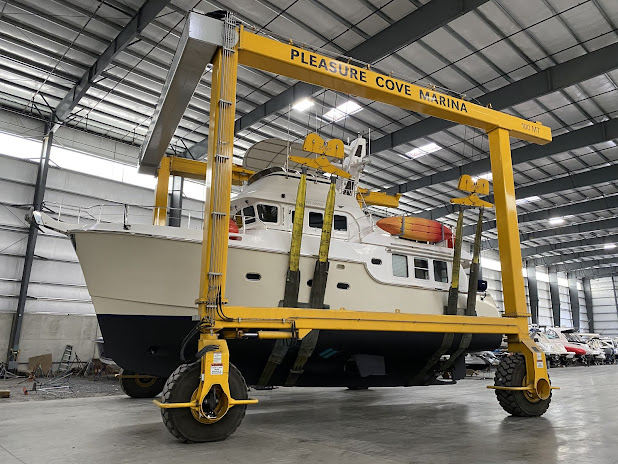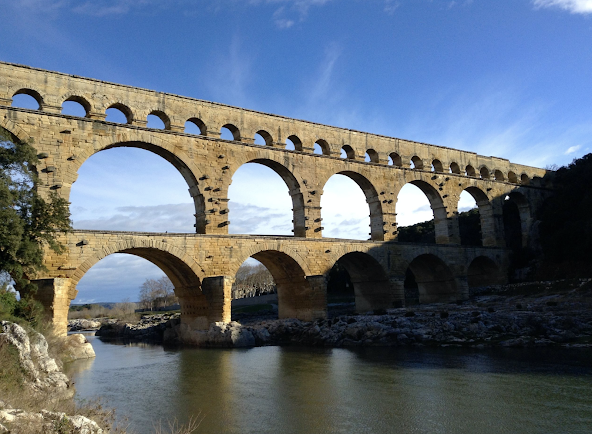Hydraulics: The Amazing Science And Machinery That Has Changed The World
The idea for this post came to me on October 13, 2020. We were watching a 100 ton capacity Marine Travelift pick up our 42 ton boat from summer storage, carry it about 2,000 feet, and then lower it into Chesapeake Bay.
My dad and I couldn’t get our minds around how the Travelift's small engine could do so much work!
Marine Travelift told us the engine in that box is a John Deere 4.5 liter with just 139 hp. You can tell from the steel lines that the hydraulic pump is in there too.
That engine is smaller than the one which powers our Nordhavn. And yet it was moving the heavy steel Travelift forward and backward, up and down inclines, making sharp turns with its all-whee drive while overcoming major friction from its airplane-size tires, and raising and lowering our 85,000 lb boat. All this without breaking a sweat. In fact, it was running at less than 50% its capacity!
Since Travelifts have a lot of hydraulics, my dad assigned me this blog post: "learn how hydraulics works and make a story out of it."
As we discussed the subject, we were amazed to realize how much of a role hydraulics had been playing in our live-aboard lives -- directly and indirectly -- without our thinking about it.
Directly, our boat’s steering is hydraulic when we use the Simrad auto-helm or navigation. Our engine’s ZF transmission shifts gears hydraulically. And our Trac stabilizers are hydraulic. Then we thought harder... Our Steelhead telescoping davit (crane), which raises and lowers our tender from the upper deck, is hydraulic. And the tilt mechanism for the Honda outboard on our tender is hydraulic too.
This is our starboard side hydraulic stabilizer system. Here, hydraulic power moves 7.5 sq ft underwater fins rapidly to counter our boat's roll. As you can imagine, it takes a lot of strength to move things that size that quickly under water.
Indirectly, it gets even more amazing. Yes there's the Travelift. But in addition, some of the locks we went through on the Erie Canal (the newer ones) were hydraulic. Some of the newer lift bridges we passed through on the Intra-coastal were hydraulic (replacing the counterweighted bascule ones). And some of the lift-gates we’ve passed by on the Intracoastal that control water levels and storm floods were hydraulic.
There's more. The fights we’ve taken traveling to and from the boat have all sorts of hydraulics, including landing gear, brakes, flaps, flight controls, spoilers, and reverse thrusters. Even our rental cars and the Uber and Lyft rides we’ve taken all had hydraulics for their steering and brakes.
In other words, hydraulics is all around us and we take it for granted.
Until today.
It’s time to learn about hydraulics and, especially, how that huge Travelift, can do so much with just a tiny engine.
But before that, here's a question. Is the word hydraulics singular or plural? Do we say "learn how hydraulics work, or "learn how hydraulics works?" Well, I looked it up. The noun hydraulics is referred to as "uncountable: plural in form but singular in construction." Therefore, it is correct to say "let's learn how hydraulics works."
__________
For starters, a little etymology (which means "the study of the origin of words"). The word hydraulics comes from the Greek word hydraulikos, which is a combination of hydor (Greek for water) and aulos (Greek for pipe).
So the Greeks invented hydraulics? Actually, no. We need to go way further back in time than that.
While today's hydraulics is known as "a branch of science concerned with the conveyance of liquids as a source of mechanical force or control" (definition from Oxford languages), in earlier times, hydraulics was basically anything that redirected water.
The evolution of hydraulics can be broken down into three basic eras.
__________
In Ancient Times
Hydraulics has been traced to 6,000 BC (that's 8,000 years ago). The Liangzhu culture of China used hydraulics when they made dams, levees, and ditches. No, this isn't hydraulics as we know the word today, but it is amazing early engineering. Man was beginning to figure out how to harness nature.
Fast forward to about 3,000 BC (5,000 years ago) to Mesopotamia and Egypt. Farmers on the Tigress and Euphrates and Nile rivers figured out how to redirect water to keep crops irrigated year round. The Egyptians were even more ingenious though. They would redirect the sediment-rich water into specific areas called "plot points," allow the water to evaporate, then grow crops in the enriched soil. But they were even more ingenious than that. They actually developed a "water clock," which allowed them to measure elapsed time by regulating the flow of water, drip by drip, through vessels with sloped sides. The Mesopotamians also had a water clock, only theirs tracked time by measuring the weight of the passing water.
Part of an Egyptian water clock. Photo source: Wikimedia Commons.
In Persia, around 500 BC, they began to actually bore into the sides of mountains and then dug shafts down from those tunnels to extract water which they then channeled out to their crops. These irrigation systems were called qanats. Qanats allowed them to be very good at farming even through times of drought. But they were even more ingenious with their hydraulics. They created something called the Shushtar Historical Hydraulic System, which is considered "a masterpiece of creative genius." It consisted of watermills, dams, tunnels, canals, pools, and waterfalls. This system inspired other cultures (i.e. the Romans) to develop similar infrastructures and to improve upon them.
In Sri Lanka, by around 400 BC, they had constructed around 15,000 dams to make 10,000 water tank reservoirs, which enabled them to cultivate vast amounts of their staple food, rice, despite seasonal rain shortages. This system is still in use today!
This is a man-made sluice gate from the Sorabora Wewa reservoir in Sri Lanka. The reservoir was built sometime between 161 BC and 137 BC. Photo source: Wikimedia Commons.
The Romans are well known for doing amazing things with hydraulics. They are credited with constructing elaborate aqueducts to bring water to their cities, making huge watermills, and using hydraulics for mining. They are also credited with developing pubic water works for bathing and managing sewage.
Pont du Gard, an ancient Roman aquaduct. Photo source: Wikimedia Commons.
Over the millennia, China continued to innovate using hydraulics, developing water-powered mechanisms to haul rice, crush ore, and power bellows. Around 100 AD, a Chinese engineer even developed an early, water-powered, very sophisticated astronomical instrument called an armillary sphere.
The Chinese kept making increasingly complex hydraulic clocks for centuries. Su Song, who lived around 1,000 AD and was considered a genius in many fields, including engineering, created one that was especially accurate, because he obsessed over the precise flow of its water power. It was also extraordinarily complex. It was 40 feet tall and weighed between 10 and 20 tons. It featured dozens of decorative mannequins, opened and closed doors, played gongs, and beat drums. (Now that's a coo-coo clock!) Though it was destroyed by an invading army, the plans for its design survived, and scaled down replicas have since been made. I found this really cool animation video which shows the insides of his clock working. It's not long and is really worth watching. Link: https://vimeo.com/glezakos/tower
Replica of Su Song's clock. It looks to be about 1/2 scale. Photo source: Revolution Watch.
__________
In More Recent Times
A great leap forward in hydraulics was made by Joseph Bramah, an English inventor and locksmith, who lived between 1748 and 1814. He is considered the father of hydraulics as we know it because he inverted the hydraulic press.
Bramah's revolutionary hydraulic press. Photo source: Florida Center for Instructional Technology.
But clever as Bramah was, he could not have created his hydraulic press without knowing Pascal's law. As Isaac Newton famously and humbly said...
Pascals law, which Bramah applied, states that any pressure on a trapped fluid is transmitted equally throughout the fluid. He developed the equation P = F/A.
P is pressure, F is force, and A is area.
Why is it the most brilliant equations seem so simple? :)
An illustration of Pascal's Law. Photo source: Wind Principles.
Applying Pascal's Law through good engineering can provide massive "mechanical advantage."
What exactly is mechanical advantage? "Mechanical advantage is the ratio of the force produced by a machine to the force applied to it, used in assessing the performance of a machine" (definition from Oxford languages).
The easiest way to illustrate mechanical advantage is the lever. Incredible lifting power can happen depending on the length of the arm and the placement of the fulcrum.
Photo source: Vista Heights 8th Grade Science.
Here's a real world example of mechanical advantage: my dad moving boulders off the beach at our cottage, inch by inch. By placing the fulcrums (smaller rocks) so close to the big rocks, and by using long levers, he was able to clear rocks that weighed over twice his own weight.
In Present Day
Today's hydraulics is a highly developed branch of science. Also called "fluid power systems," hydraulics has become increasingly powerful, with a broad range of engineering applications. Hydraulics has allowed us to create modern engineering miracles such as the Swiss Gotthard rail tunnel, which runs 36 miles long under the Swiss Alps, and was created using four boring machines. Each of those stretched 1,345 feet long, including conveyors.

One of the four massive hydraulic Herrenknecht Gipper TBMs used to bore the tunnel. Photo source: Herrenknecht.com.
Modern hydraulics even play an important role in space exploration. You can imagine how sophisticated those systems must be, having to survive extreme temperature variations and high levels of radiation.
__________
So in general, how do modern hydraulics, like the Travelift, work?
There are four main parts to a system:
1. The reservoir: This is where the fluid is held (more about the fluid below). The reservoir also transfers heat into and out of the hydraulic system. And it helps to remove air and different types of moisture from the stored fluid.
2. The pump: This is responsible for moving mechanical energy into the system. It does so by moving the fluid from the reservoir. Though there are different types of hydraulic pumps (including gear pumps, piston pumps, and vane pumps), each works on the same basic principle of moving fluids through pressure.
3. The valves: These start and stop the system and direct where, and to what degree, the fluid moves.
4. The actuators: These take the generated hydraulic energy and change it back into mechanical energy for use. This may be done a couple of different ways. The system may use a hydraulic motor to generate rotary motion, or it can be done using a hydraulic cylinder to create linear motion.
As for the fluid, it's pretty special.
In fact, it's the fluid that actually permits the transfer of energy in a hydraulic system!
There are 5 main reasons why water wouldn't do for hydraulic fluid:
1. Boiling point: Hydraulic systems get hot while in use. So much so that water could boil. Boiling would reduce the effectiveness of the system (since gasses compress far easier than liquids. Boiling could also cause cavitation (another form of bubbles) and the shockwaves from those bubbles could cause pitting (wear and tear) of the metal components. The higher boiling point of hydraulic fluid helps prevent this.
2: Freezing point: While freezing can cause all kinds of damage to hydraulic seals, freezing of hydraulic fluid could starve pumps and other components of fluid and cause them to fail. Hydraulic fluid has a much lower freezing point than water.
3: Oxidation and corrosion: Water is something called an electrolyte (meaning it conducts electricity) and so it will cause rust (rust is a form of corrosion specifically referring to the oxidation of iron or its alloys) whenever any air leaks into a hydraulic system (which does happen). Water can also cause galvanic corrosion, which is a type of corrosion that happens when two different metals touch. Hydraulic fluid is not an electrolyte nor does it cause corrosion.
4: Lubrication and sealing: Hydraulic fluid (also called hydraulic oil) is far slipperier than water, so it will reduce friction at siding surfaces such as cylinders and valves. Yet the fluid itself helps to seal the internal components.
5: Organic growth: In perfectly sterile water and a closed system, there would be no organic growth. But achieving and maintaining that much sterility is extremely difficult. Hydraulic fluids greatly discourage organic growth.
__________
So now we know how hydraulics evolved, how it works, and how powerful it can be. But hydraulics can't take all the credit for the power of a Travelift. The engineers use one other important trick to multiply the lifting capacity of their hoists a lot without adding horsepower.
That trick is another form of mechanical advantage. One developed by one of the greatest inventors of all time: Archimedes.
The invention?
The pulley! He invented it in the 3rd century BC. That's 2,300 years ago.
In fact, if you look closely at the Travelift that moved us, you'll see plenty of them, on each side of the boat.
I could go on an on about these because I've watched a ton of videos about the different rigging of pulleys and how they generate mechanical advantage. But I'll just share a couple of interesting points about them before moving on.
Firstly, a single pulley does not give mechanical advantage. A person lifting an object with a single pulley is only transferring the effort of the Iift. It's simply easier to lift something by using an overhead pulley and the weight of your body (gravity) to pull downward. The mechanical advantage of pulleys starts when a second pulley is added. Adding a second pulley reduces the lifting force to 1/2, meaning the mechanical advantage is 2x. Adding a third pulley reduces the lifting force to 1/3, a 3x mechanical advantage. And so forth. You can keep adding pulley after pulley and the lifting force will keep getting smaller. However, at some point the friction of all those pulleys and more and more cable and more space required and more cost will make doing this inefficient.
I tried to calculate how much efficiency Travelift gains with the pulley system it engineered for our 100 ton lift, but I couldn't see all of its rigging. However, I believe the 4 compound pulleys I could see (the ones hanging by cables), along with the pulleys mounted to the rails above them must offer major mechanical advantage. As much as 16x!
__________
So the mystery is solved.
A Travelift is able to lift our boat through the combination of: a) converting the potential energy of fossil fuel into kinetic energy via its diesel engine; b) the massive mechanical advantage of its hydraulics system; and c) the mechanical advantage of its pulleys.
Of course all this wouldn't be possible without the strength of its steel frame, the strength of its cables and one of the most amazing inventions of all time...
The wheel. 🙂
__________
P.S. I like to add fun and interesting things at the bottom of my posts. So here goes.
1. If you want to see the heaviest crane Iift of all time, here is an article about it and a video of it lifting the top of an oil rig. You can see it also uses the combined mechanical advantage of hydraulics and a lot of pulleys.
3. For more about how pulleys provide mechanical advantage, watch this cool video by Destin of the Youtube channel "Smarter Every Day." All his videos are really good, btw. I've learned a lot watching them.
4. This is a great video that does an excellent job explaining all about mechanical advantage. The host, Mark Rober, also has a popular Youtube channel. In fact, he has the best YouTube channel I've ever come across. He has to be pretty smart to work 9 years at NASA, with 7 of those on the Mars Curiosity Rover.

























Salter, this is one of my favorite of your blog posts. I really enjoy learning about things through your eyes. I was never a huge science student, although I really enjoyed physics and chemistry. You make science seem fun and interesting! I know your dad has a lot to do with that. I have always said there's an engineer somewhere inside him. Thanks for teaching me about hydraulics...and pulleys! And I think Mark Rober and Destin Sandlin are probably the best science teachers ever. :)
ReplyDelete